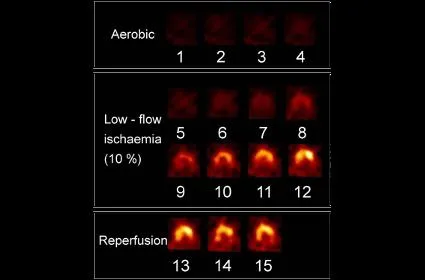
Sequential 18FDG PET scans through an isolated perfused rat heart exposed to regional low-flow ischemia ad reperfusion
Our group has several ongoing research projects which employ molecular imaging techniques to study and characterise cardiovascular disease. Historically, much of this work stemmed from using our unique combined PET/MR system (which we called PANDA) to simultaneously track cardiac glucose uptake by 18FDG PET and cardiac energetics (by 31P NMR spectroscopy), and relate them to each other. While this work continues, and now focuses investigating the role of hexokinase in maintaining cardiac viability and cardioprotection, our research interests, available technologies and techniques have expanded significantly. We currently have active research programs using PET to quantify and characterise cardiac hypoxia and oxidative stress, using SPECT to observe and characterise platelet adhesion to the myocardium and study the effects of platelets on arrhythmogenesis, and MR techniques including Dynamic Nuclear Polarisation to study cardiac metabolism of hyperpolarised substrates such as pyruvate or lactate during evolving heart disease.
Novel Contrast Agents for Cardiovascular Imaging
We have further research focusing on the use of magnetic resonance imaging (MRI) as a non-invasive tool to image cardiovascular disease, and in particular atherosclerosis. One area of research is concerned with the detection of specific plaque components associated with plaque progression and instability, which would eventually allow the discrimination of unstable plaques with a higher likelihood of causing an acute event from stable plaques. Utilising animal models of accelerated atherosclerosis and plaque disruption we can begin to understand the biology of plaque development and identify possible imaging targets for the development of contrast agents. Currently, we are investigating the usefulness of several novel target specific contrast agents (elastin, fibrin, macrophages) including gadofosveset (Vasovist), an albumin-binding gadolinium-based contrast agent, to study endothelial dysfunction and its role in plaque formation and stability in both the pre-clinical and clinical setting